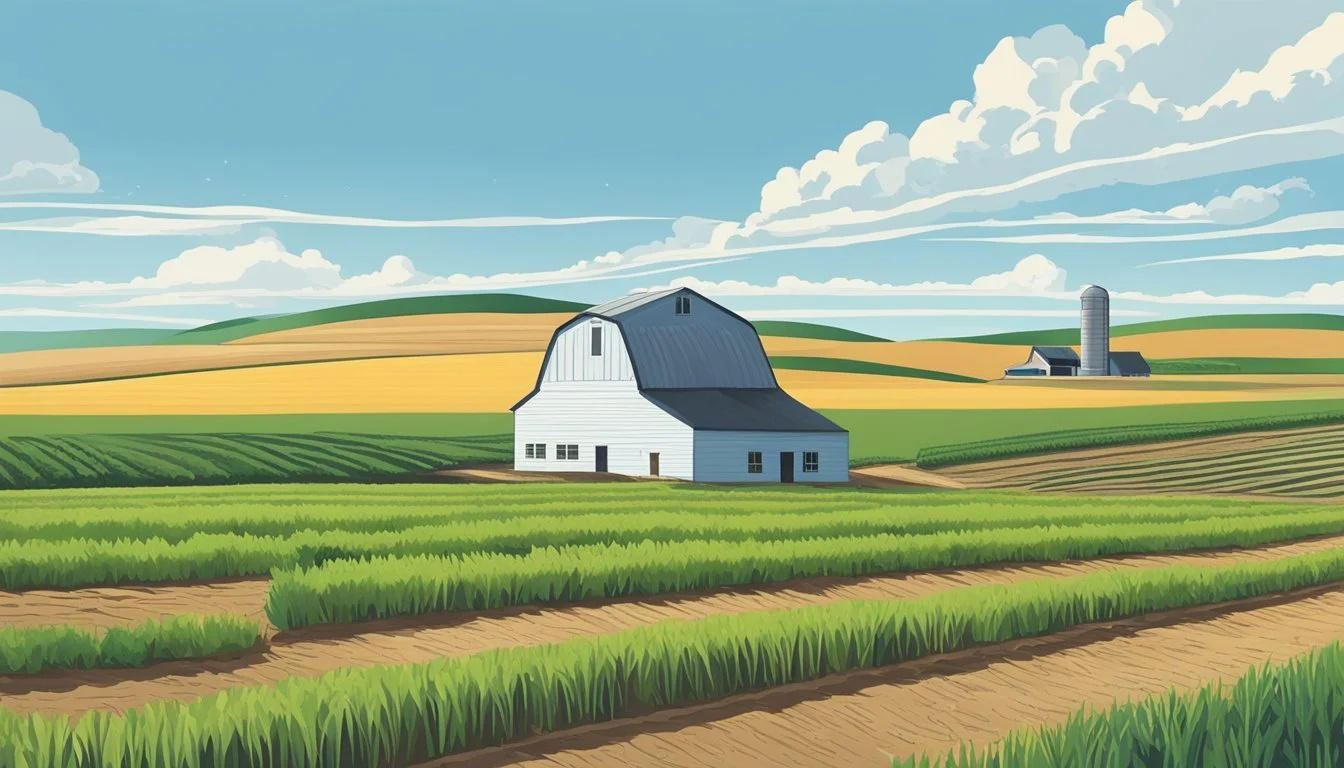Nebraska Farm Land for Lease
Opportunities and Options
This Article is Part of Our Guide on Navigating Agricultural Leases Across the US
Nebraska's farm land is characterized by its rich, fertile soil and diverse agricultural offerings, making it a sought-after location for farmers and investors alike. The state's economy is deeply rooted in agriculture, with a strong emphasis on commodities like corn, soybeans, (how long do soybeans last?) cattle, and pork. When it comes to leasing farm land in Nebraska, potential lessees find a market that is both active and dynamic. Various properties across the state offer opportunities for different kinds of agricultural production, ranging from crop farming to livestock raising.
Land leasing in Nebraska provides a practical alternative to purchasing, allowing farmers to expand operations or begin new ventures without the upfront capital expenditure required to buy land. As of recent reports, the market value of agricultural land in Nebraska has shown a significant increase, indicating a robust interest in both leasing and ownership. Leases in the state are typically structured within a clear legal framework, with both verbal and written agreements in place – verbal leases often run from March 1st to the end of February whereas written leases expire as outlined in their respective agreements.
The state has a varied selection of farm land for lease, accommodating different scales of agricultural operations. Lessees consider numerous factors such as land quality, size, location, and accessibility to infrastructure. Additionally, the financial aspects of leasing, such as the cost per acre and lease terms, play critical roles in decision-making. With a wide range of available properties, individuals and entities looking to lease farm land in Nebraska are encouraged to assess their options carefully to align with their farming goals and budgetary considerations.
Understanding Nebraska Farm Land Leasing
Nebraska farm land leasing involves distinct lease types and the necessity of formal agreements. These leases are essential in defining the relationship between landlords and tenants and determining the terms of land use and payments.
Types of Leases
Cash Rent Leases: Tenants pay a fixed amount, known as cash rental rates, to farm an area of land. Rates can vary significantly depending on the location and quality of the land.
Fixed Cash Rent: A set payment regardless of crop prices or yields.
Flexible Cash Rent: Payment varies based on prices, yields, or revenues.
Crop Share Leases: The landlord and tenant share costs and revenues. Typically, the landlord receives a percentage of the crop or revenue in exchange for the use of their land.
Input Costs: Shared between parties, often proportional to their share of the revenues.
Revenue Split: Common splits include 1/3 to the landlord and 2/3 to the tenant, but can vary based on the agreement.
Importance of Written Leases
A written lease provides a clear, legal documentation of the terms agreed upon by both the landlord and tenant, minimizing the potential for misunderstandings or disputes.
Benefits of Written Leases:
Clarity: Clearly outlines obligations, payment schedules, and land use expectations.
Security: Offers legal protection for both parties should disagreements arise.
All parties should ensure that written leases comprehensively cover the terms of the rent, responsibilities, and expectations to safeguard their interests in Nebraska's agricultural land leasing arrangements.
Current Market Insights
Nebraska's farmland market is characterized by dynamic changes in land values and rental rates, influenced by both economic forces and environmental circumstances.
Nebraska Farm Real Estate Market Survey
The 2023 Nebraska Farm Real Estate Market Survey reveals that there has been a significant increase in the market value of agricultural land. It specifically notes a 14% rise over the previous year, elevating the average to $3,835 per acre. This survey is fundamental in providing insight into the current trends affecting Nebraska's farmland market.
Rental Rates and Land Values
Regarding rental rates, data shows variations depending on region and land type. Cropland generally commands higher rental rates compared to pastures due to its potential for higher-yielding crop production. Cash rental rates mirror changes in commodity prices, which are determined by both the state's production levels and the global market demand for these commodities.
Dryland Cropland: Higher rates due to potential yields.
Irrigated Cropland: Premium rates in response to water access.
Pastureland: Lower rates reflecting the lower intensive use.
Economic and Environmental Influences
Economic forces such as commodity prices and interest rates play a crucial role in shaping the market. Recent trends in crop prices, reflecting global demand and local harvest outcomes, directly affect the profitability and, consequently, the value of farmland. On the environmental side, factors like drought can impact land use decisions and valuations. Additionally, property tax policies and potential credits are essential considerations for stakeholders in the Nebraska farmland market, as they influence the overall cost of owning and leasing farmland.
Geographical Variation in Leasing
Leasing rates for farmland in Nebraska show clear differences based on region and land type, affecting local market values and the decisions of tenants and landowners alike.
Regional Differences
In Nebraska, leasing prices and values can vary significantly by region. The northeast region has a higher prevalence of cash leases, whereas crop share leases are more common in other areas. For example, roughly 68% of all leases in northeastern Nebraska are cash leases.
Northwest and Central Regions: These regions may have a mix of cash and crop share leases with variations influenced by local market forces and the quality of the land.
South, Southeast, and Southwest: These regions also display unique trends in land values and lease types, further influenced by factors such as irrigation potential and land use.
Market values have seen fluctuations, with a reported 14% increase to an average of $3,835 per acre as per the latest survey data from Nebraska.
Land Type Variability
Leasing rates are not uniform across different land types in Nebraska, with irrigated, dryland cropland, and grazing land each commanding different averages.
Irrigated Cropland: There's a distinction between center pivot irrigated cropland, which tends to be more valuable, and gravity irrigated cropland. The presence of a pivot often leads to higher rental rates.
Dryland Cropland: This type tends to have lower lease prices compared to irrigated fields due to the variability in crop yields.
Grazing Land: Grazing land and hayland values fluctuate based on the quality of the forage and local demand for grazing.
The following table outlines the leasing rates per acre in different regions for various types of land:
Region Irrigated Cropland (Pivot) Dryland Cropland Grazing Land East $XXX - $XXX $XXX - $XXX $XXX - $XXX North $XXX - $XXX $XXX - $XXX $XXX - $XXX Central $XXX - $XXX $XXX - $XXX $XXX - $XXX
These rates are averages and can vary within each region depending on specific local market conditions and the quality of the parcels.
Costs and Returns on Leased Land
When leasing farmland in Nebraska, understanding both the expenses involved and the potential revenue is crucial for landlords and tenants. Effective expense management is key to maintaining profitability, while accurate revenue calculations can ensure equitable leasing arrangements.
Expense Management
Input expenses: These are costs directly associated with crop production, such as seeds, fertilizers, and pesticides. On pasture lands, maintenance expenses like fencing and water systems contribute to input costs.
Premiums: Some leases may include insurance premiums to mitigate production risk, which can affect the overall expenses.
Payment: For cash leases, the payment is a fixed amount negotiated between the landlord and tenant. In contrast, crop share leases involve variable payments tied to the size and value of the crop yield.
Pasture and Grazing Expenses: Pasture leases typically incur lower input expenses. In Nebraska, the average cost for grazing a cow-calf pair is $62.55 per month, amounting to about $312.75 - $336.75 over a five-month grazing period.
Production Risk: Tenants should consider production risks, such as weather-related crop failures, which can impact the cost of farming when engaging in a crop share lease.
Revenue Calculations
Pasture Leasing: Revenue from pasture leases is based on the grazing fees charged per cow-calf pair per month.
For example, grazing leases in Nebraska's East region averaged $62.55 per month per pair.
Crop Share Lease: Revenue for crop share leases depends on the actual yield. The landowner receives a percentage of the crop yield as payment.
Rates:
Grazing Lease: Average $60 per acre
Crop Share Lease: Payment is based on yield percentage.
Landlords and tenants must work together to determine fair and mutually beneficial lease agreements based on current market data and the potential output of the land.
Professional Insights and Resources
In the realm of Nebraska farmland leasing, professionals rely on a blend of rigorous academic research and seasoned expert opinions to navigate the market. Both approaches offer insights that inform leasing decisions and valuation.
Academic and Market Surveys
The University of Nebraska-Lincoln conducts an annual 2023 Nebraska Farm Real Estate Market Survey. This comprehensive survey gathers data from land industry professionals, including appraisers, farm and ranch managers, and agricultural bankers. The collected information covers trends in land values and rental rates, distilled into averages for various regions across Nebraska. It's important for stakeholders to consult this survey for a grounded understanding of the market. Additionally, the National Agricultural Statistics Service provides county-level data that further refines local market understanding.
Expert Opinion
Agricultural economist Jim Jansen, associated with the University of Nebraska-Lincoln, offers professional insights into the Nebraska farmland leasing landscape. Jansen, along with his peers, can provide a nuanced interpretation of survey findings. Their informed perspectives help landowners and tenants steer through the complexities of lease agreements, and ensure that they are attuned to current trends and economic indicators. As such, their expert opinions are a valuable supplement to survey data for those engaged in farmland transactions.
Financial Considerations for Leasers
When entering a lease agreement for farmland in Nebraska, leasers must evaluate financial components such as loan conditions and the potential for land appreciation. These factors can significantly impact the profitability and viability of their agricultural operations.
Loan and Interest Rates
Leasers often rely on loans to finance their operations, making awareness of current interest rates crucial. Interest rates impact monthly payments and overall costs associated with leasing land, directly affecting cash flow. They must consider:
Prime Lending Rates: Interest rates are usually pegged to the prime rate set by banks.
Fixed vs. Variable Rates: Fixed rates provide consistency over the loan term, while variable rates may fluctuate, affecting repayment amounts.
Recent data indicates a trend in Nebraska land values, potentially affecting loan-to-value ratios which are critical when lenders assess risk.
Investment and Value
Farmland in Nebraska is not merely an operational expense but a tangible investment. Leasers should consider the historical appreciation of agricultural land values in the state:
Year Avg. Land Value per Acre % Change 2023 $3,835 14%
Cash rent must also reflect current land value and expected inflation rates, with an understanding that land can serve as a hedge against inflation. Furthermore, leasers seeking operation expansion must weigh the potential for increased income against the higher costs of renting additional land.
Investigation into Nebraska agricultural land values suggests the importance of aligning leasing strategies with long-term investment goals, rather than focusing solely on immediate operational needs.
Legal Aspects of Farm Land Leasing in Nebraska
The legal framework for leasing farm land in Nebraska is essential for both landowners and tenants to understand, ensuring that all parties are aware of their rights and obligations.
Lease Termination
Nebraska Supreme Court Ruling: In Nebraska, for verbal farm land leases, which are common, the lease year begins on March 1st. This has implications for lease termination.
Notice Period: To terminate a verbal lease, a "notice to quit" must be provided no less than six months before the lease year ends, which is by September 1st of the preceding year.
Land Use Regulations
Written Agreements: While not predominant in Nebraska, written leases may define specific land use regulations and thereby reduce misunderstandings.
Regulatory Compliance: All agricultural leases, whether verbal or written, must comply with local and state land use regulations. This includes but is not limited to crop restrictions, environmental protections, and zoning laws.
Documentation and Clarity: It is advisable for tenants and landowners to develop a clear written lease to outline responsibilities, even though it is not mandated by Nebraska law, to avoid potential disputes surrounding land use regulations.
Livestock Grazing Agreements
In Nebraska, livestock grazing agreements are essential for producers, detailing the terms under which cattle and other approved farm animals can graze on leased pasture land. These agreements establish the financial and operational guidelines, ensuring both the landowner and lessee benefit from the arrangement.
Pasture Rental Rates
Cash rent for pasture land is determined by several factors, including land quality, geographic location, and current commodity prices. In Nebraska, cash rental rates are documented and can vary significantly across the state. A producer can expect to pay different rates for irrigated versus non-irrigated cropland.
Irrigated cropland (per acre): Higher rates due to the potential for more consistent and intensive production.
Non-irrigated cropland (per acre): Lower rates but can vary based on soil quality and local rainfall patterns.
Pasture land (per acre): Dependent on forage quality and availability, factors that can influence the stocking rate.
It is advisable for producers to refer to the latest USDA National Agricultural Statistics Service for Nebraska or extension services to get the most current rental rate statistics.
Cow-Calf Pair Considerations
When leasing pasture for a cow-calf operation, the rental rates might be set per cow-calf pair, reflecting the cost of grazing a nursing cow and her calf for a season. These rates are influenced by the carrying capacity of the land and can be affected by grazing pressure and environmental conditions like drought.
Expected rental rates: Calculated on a per cow-calf pair basis.
Adjustments: May occur in response to environmental impacts that affect pasture quality.
For both parties to safeguard their interests, agreements should detail how and who decides to reduce stocking rates during adverse conditions. Producers need to ensure that the leasing agreement provides the flexibility to adjust cattle numbers to maintain a balance with forage availability and land health.







